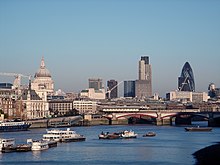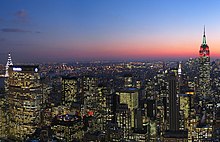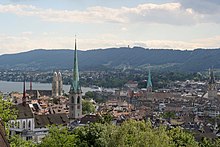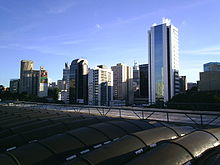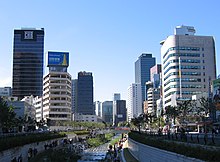This is an old revision of this page, as edited by Arthur Rubin (talk | contribs) at 14:41, 6 November 2006 (Reverted edits by Elk Salmon (talk) to last version by 59.145.136.1). The present address (URL) is a permanent link to this revision, which may differ significantly from the current revision.
Revision as of 14:41, 6 November 2006 by Arthur Rubin (talk | contribs) (Reverted edits by Elk Salmon (talk) to last version by 59.145.136.1)(diff) ← Previous revision | Latest revision (diff) | Newer revision → (diff)| This article may be unbalanced toward certain viewpoints. Please improve the article by adding information on neglected viewpoints, or discuss the issue on the talk page. |
A global city and world city, or world-class city, is a concept introduced by a group of academics including the Globalization and World Cities Study Group and Network (GaWC), based primarily at Loughborough University. The concept includes the postulation that some cities have a direct and tangible effect on global affairs through socioeconomic, cultural, and/or political means, whilst others do not. This leads to the need to develop rules to categorise cities as global or non-global, and to sub-categorise global cities in various ways.
In recent years, the term has become increasingly familiar, because of the rise of globalization (i.e., global finance, communications, and travel). The term "global city", as opposed to megacity, was first coined by Saskia Sassen in a seminal 1991 work.
General characteristics
It has been argued that global cities are those sharing the following characteristics:
- International, first-name familiarity; whereby a city is recognised without the need for a political subdivision. For example. although there are numerous cities and other political entities with the name Paris or variations on it, one would say "Paris", not "Paris, France".
- Active influence and participation in international events and world affairs; for example, New York City is home to the United Nations headquarters complex and consequently contains a vast majority of the permanent missions to the UN.
- A fairly large population (the centre of a metropolitan area with a population of at least one million, typically several million).
- A major international airport (for example, London Heathrow Airport) that serves as an established hub for several international airlines.
- An advanced transportation system that includes several freeways and/or a large mass transit network offering multiple modes of transportation (rapid transit, light rail, regional rail, ferry, or bus).
- In the West, several international cultures and communities (such as a Chinatown, a Little Italy, or other immigrant communities). In other parts of the world, cities which attract large foreign businesses and related expatriate communities; for example, Singapore, Shanghai, Hong Kong, Tokyo, and Moscow.
- International financial institutions, law firms, corporate headquarters (especially conglomerates), and stock exchanges (for example the London Stock Exchange, the New York Stock Exchange or the Tokyo Stock Exchange) that have influence over the world economy.
- An advanced communications infrastructure on which modern trans-national corporations rely, such as fiberoptics, Wi-Fi networks, cellular phone services, and other high-speed lines of communications.
- World-renowned cultural institutions, such as museums and universities.
- A lively cultural scene, including film festivals (for example the Toronto International Film Festival), premieres, a thriving music or theatre scene (for example, West End theatre and Broadway); an orchestra, an opera company, art galleries, and street performers.
- Several powerful and influential media outlets with an international reach, such as the BBC, Associated Press, Reuters, The New York Times, The Times, or Agence France-Presse.
- A strong sporting community, including major sports facilities, home teams in major league sports, and the ability and historical experience to host international sporting events such as the Olympic Games, Football World Cup, or Grand Slam tennis events.
To some, London, New York City, Paris, and Tokyo have been traditionally considered the 'big four' world cities – not coincidentally, they also serve as symbols of global capitalism. However, many people have their own personal lists, and any two lists are likely to differ based on cultural background, values, and experience.
In certain countries, the rise of suburbia and the ongoing migration of manufacturing jobs to these countries has led to significant urban decay. Therefore, to boost urban regeneration, tourism, and revenue, the goal of building a "world-class" city has recently become an obsession with the governments of some mid-size cities and their constituents.
The phenomenon of world-city building has also been observed in Buenos Aires, Santiago, Frankfurt, Montréal, Sydney, Mexico City and Toronto: each of these cities has emerged as large and influential.
GaWC Inventory of World Cities (1999 Edition)
An attempt to define and categorise world cities was made in 1999 by the Globalization and World Cities Study Group and Network (GaWC), based primarily at Loughborough University in Loughborough, Leicestershire, England. The roster was outlined in the GaWC Research Bulletin 5 and ranked cities based on provision of "advanced producer services" such as accountancy, advertising, finance and law, by international corporations. The GaWC inventory identifies three levels of world cities and several sub-ranks.
Note that this roster generally denotes cities in which there are offices of certain multinational companies providing financial and consulting services rather than other cultural, political, and economic centres. There is a schematic map of GaWC cities at their website.
Alpha world cities (full service world cities)
- 12 points: London, New York, Paris, Tokyo
- 10 points: Chicago, Frankfurt, Hong Kong, Los Angeles, Milan, Singapore
- Refer to Official GaWC List.
Beta world cities (major world cities)
- 9 points: San Francisco, Sydney, Toronto, Zürich
- 8 points: Brussels, Madrid, Mexico City, São Paulo
- 7 points: Moscow, Seoul
Gamma world cities (minor world cities)
- 6 points: Amsterdam, Boston, Caracas, Dallas, Düsseldorf, Geneva, Houston, Jakarta, Johannesburg, Melbourne, Osaka, Prague, Santiago, Taipei, Washington
- 5 points: Bangkok, Beijing, Montreal, Rome, Stockholm, Warsaw
- 4 points: Atlanta, Barcelona, Berlin, Budapest, Buenos Aires, Copenhagen, Hamburg, Istanbul, Kuala Lumpur, Manila, Miami, Minneapolis, Munich, Shanghai
Evidence of world city formation
Strong evidence
- 3 points: Athens, Auckland, Dublin, Helsinki, Luxembourg, Lyon, Mumbai, New Delhi, Philadelphia, Rio de Janeiro, Tel Aviv, Vienna
Some evidence
- 2 points: Abu Dhabi, Almaty, Birmingham (UK), Bogotá, Bratislava, Brisbane, Bucharest, Cairo, Cleveland, Cologne, Detroit, Dubai, Ho Chi Minh City, Kiev, Lima, Lisbon, Manchester, Montevideo, Oslo, Riyadh, Rotterdam, Seattle, Strasbourg, Stuttgart, The Hague, Vancouver
Minimal evidence
- 1 point: Adelaide, Antwerp, Aarhus, Baltimore, Bangalore, Bologna, Brasília, Calgary, Cape Town, Colombo, Columbus, Dresden, Edinburgh, Genoa, Glasgow, Gothenburg, Guangzhou, Hanoi, Kansas City, Leeds, Lille, Marseille, Richmond, St. Petersburg, Tashkent, Tehran, Tijuana, Turin, Utrecht, Wellington
GaWC Leading World Cities (2004 Edition)
An attempt to redefine and recategorise leading world cities was made by PJ Taylor at GaWC in 2004.
This ranking list is referred to as the Official GaWC List.
Global Cities
Well rounded global cities
- 1. Very large contribution: London and New York City.
- Smaller contribution and with cultural bias: Los Angeles, Paris and San Francisco.
- 2. Incipient global cities: Amsterdam, Boston, Chicago, Madrid, Milan, Moscow, Toronto.
Global niche cities - specialised global contributions
- 1. Economic: Hong Kong, Singapore, and Tokyo.
- 2. Political and social: Brussels, Geneva, Strasbourg and Washington.
World Cities
Subnet articulator cities
- 1. Cultural: Berlin, Copenhagen, Melbourne, Munich, Oslo, Rome, Stockholm.
- 2. Political: Bangkok, Beijing, Vienna.
- 3. Social: Manila, Nairobi, Ottawa.
Worldwide leading cities
- 1. Primarily economic global contributions: Frankfurt, Miami, Munich, Osaka, Singapore, Sydney, Zurich
- 2. Primarily non-economic global contributions: Abidjan, Addis Ababa, Atlanta, Basle, Barcelona, Cairo, Denver, Harare, Lyon, Manila, Mexico City, Mumbai, New Delhi, Shanghai
Global Cities Conference 2006
| This article needs to be updated. Please help update this article to reflect recent events or newly available information. |
This conference took place at Liverpool Hope University, starting on 29 June 2006 and chaired by Dr. Lawrence Phillips of the Global Cities Conference at the university. Its aim was to establish what is meant by a 'global city', by examining criteria such as images, narratives, economics, planning and people's experiences. It also looked at whether the perceived 'big four' — London, Paris, New York, and Tokyo — are in fact the only candidates for global city status, or if they should in fact be joined by fast-growing cities in Asia or the developing world.
Other criteria
The GaWC list is based on specific criteria and, thus, may not include other cities of global significance or elsewhere on the spectrum. For example, cities with the following:
|
|
Table of the cities of the world
For selected criteria
| Rank | Population of city (proper) | Population of metropolitan area | Percentage foreign born | Cost of living | Metro systems by annual passenger ridership | Annual passenger air traffic (2002) | Number of billionaires (United States Dollars) |
|---|---|---|---|---|---|---|---|
| 1 | Mumbai | Tokyo | Miami | Moscow | Tokyo | London | New York City |
| 2 | Shanghai | Seoul | Toronto | Seoul | Moscow | Tokyo | Los Angeles |
| 3 | Karachi | Mexico City | Los Angeles | Tokyo | Seoul | Chicago | Moscow |
| 4 | Buenos Aires | New York City | Vancouver | Hong Kong | Mexico City | New York City | London |
| 5 | Delhi | São Paulo | New York City | London | New York City | Atlanta | Hong Kong |
| 6 | Manila | Mumbai | Singapore | Osaka | Paris | Paris | Chicago |
| 7 | Moscow | Delhi | Sydney | Singapore | London | Los Angeles | San Francisco |
| 8 | Seoul | Shanghai | Abidjan | Copenhagen | Osaka | Dallas Fort-Worth | Paris |
| 9 | São Paulo | Kolkata | London | Zurich | Hong Kong | Frankfurt | Dallas |
| 10 | İstanbul | Jakarta | Paris | Oslo | Singapore | Houston | Tokyo |
See also
References
- PERMANENT MISSIONS TO THE UNITED NATIONS, UN, 29 April 2003
- GaWC Research Bulletin 5, GaWC, Loughborough University, 28 July 1999
- The World According to GaWC, GaWC, Loughborough University
- Inventory of World Cities, GaWC, Loughborough University
- Leading World Cities, GaWC, Loughborough University
- 2006 Global Cities Conference
- ^ Chapter 5: Globalization and cultural choice, "2004 Human Development Report" (page 99), UNDP, 2004 Template:PDFlink
- Chapter 9: Urban Data, "World Ressources 1998-99", WRI, 1998 Template:PDFlink
- City Profiles, UN
- Mobility 2001, WBCSD Template:PDFlink
- WORLD URBANIZATION PROSPECTS: THE 2003 REVISION, UN, 2004 Template:PDFlink
- Urban Characteristics,City Level, 1993, "World Ressources 1998-99", WRI, 1998 Template:PDFlink
- Global Urban Indicators Database 2 (1998 data) (data sets in .ZIP), UN-HABITAT
- World Indices, Bloomberg
- J.V. Beaverstock, World City Networks 'From Below', GaWC, Loughborough University, 29 September 2005
- World-wide quality of living survey, Mercer, 10 April 2006
- The city development index, "THE STATE OF THE WORLD'S CITIES REPORT 2001", UN-HABITAT, 21 June 2006 Template:PDFlink
- ^ 2005 worldwide cost of living survey results released, Mercer, 20 June 2005
- The World's Billionaires, Forbes, 2005
- Mapping the Global Network Economy on the Basis of Air Passenger Transport Flows, GaWC, Loughborough University, 8 December 2004
- Estimated Ridership of the World’s Largest Public Transit Systems, 1998
- COMMUTER RAIL (SUBURBAN RAIL, REGIONAL RAIL) IN THE UNITED STATES: INTERNATIONAL CONTEXT, October 2003 Template:PDFlink
- Traffic Intensity by International Urban Area: 1990
- Largest seaports of the world
- The World's Best Skylines
- (registration required) Template:PDFlink
- K. O'Connor, International Students and Global Cities, GaWC, Loughborough University, 17 February 2005
- World Heritage List, UNESCO
- P. De Groote, Economic and Tourism Aspects of the Olympic Games, GaWC, Loughborough University, 21 September 2005
- http://www.iaurif.org/en/doc/studies/airports/INTRO.pdf
- INTERNATIONAL PRIVATE WEALTH MANAGEMENT, International Financial Services, December 2004 Template:PDFlink
- Forbes reports billionaire boom, BBC, 10 March 2006
- 500 richest in Russia, Finance Magazine, published by RBC. February 2006.
External links
- "U.S. Cities in the 'World City Network'", by Peter J. Taylor and Robert E. Lang, February 2005 (Full Report in PDF)
- Repository of Links Relating to Urban Places
- World Cities article by Jennifer Curtis of Charles Sturt University
- The World-System’s City System: A Research Agenda by Jeffrey Kentor and Michael Timberlake of the University of Utah and David Smith of University of California, Irvine
- The State of the World's Cities, 2001, UN Human Settlements Programme
